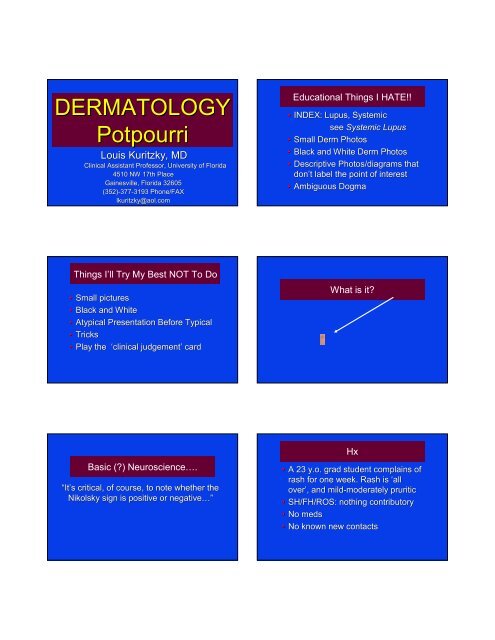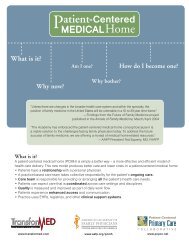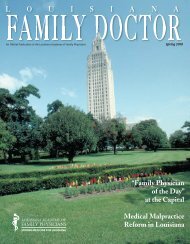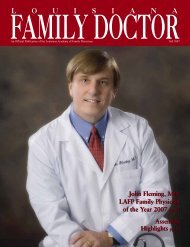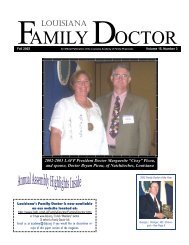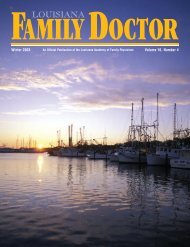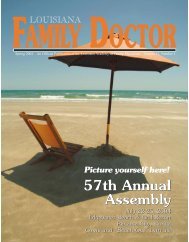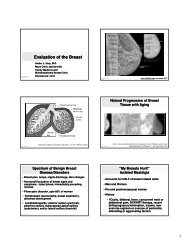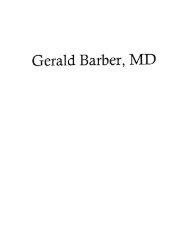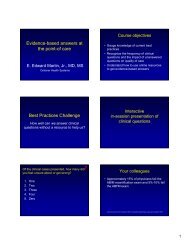DERMATOLOGY Potpourri
DERMATOLOGY Potpourri
DERMATOLOGY Potpourri
You also want an ePaper? Increase the reach of your titles
YUMPU automatically turns print PDFs into web optimized ePapers that Google loves.
<strong>DERMATOLOGY</strong><br />
<strong>Potpourri</strong><br />
Louis Kuritzky, MD<br />
Clinical Assistant Professor, University of Florida<br />
4510 NW 17th Place<br />
Gainesville, Florida 32605<br />
(352)-377<br />
377-31933193 Phone/FAX<br />
lkuritzky@aol.com<br />
Educational Things I HATE!!<br />
• INDEX: Lupus, Systemic<br />
see Systemic Lupus<br />
• Small Derm Photos<br />
• Black and White Derm Photos<br />
• Descriptive Photos/diagrams that<br />
don’t t label the point of interest<br />
• Ambiguous Dogma<br />
Things I’ll Try My Best NOT To Do<br />
• Small pictures<br />
• Black and White<br />
• Atypical Presentation Before Typical<br />
• Tricks<br />
• Play the ‘clinical<br />
judgement’ card<br />
What is it?<br />
Basic (?) Neuroscience….<br />
“It’s s critical, of course, to note whether the<br />
Nikolsky sign is positive or negative…”<br />
Hx<br />
• A 23 y.o. grad student complains of<br />
rash for one week. Rash is ‘all<br />
over’, , and mild-moderately<br />
moderately pruritic<br />
• SH/FH/ROS: nothing contributory<br />
• No meds<br />
• No known new contacts
Pityriasis Rosea: Definition<br />
• pityriasis ion [Greek: pitryon bran + iasis]<br />
♦ “a a name originally applied to a group<br />
of skin diseases characterized by the<br />
formation of fine branny scales, but<br />
now used only with a modifier”<br />
Dorland’s s Illustrated Medical Dictionary 26 th Edition<br />
1981 WB Saunders (Philadelphia)<br />
Pityriasis Rosea<br />
• Common, benign, self-limiting, limiting, usually aSx<br />
• Etiology? “there is some evidence that it is<br />
viral in origin” (Frat house and military base<br />
outbreaks)<br />
• >75% between age 10-35 (mean = 25)<br />
• Antecedent URI: 68.8%<br />
• DDx: : secondary syphilis, guttate psoriasis,<br />
viral exanthems, , drug eruption<br />
Habif T Clinical Dermatology 2004 Mosby (Philadelphia)<br />
Pityriasis Rosea: Clinical<br />
• Herald Patch: 2-102<br />
cm round-oval oval lesion<br />
appears abruptly (17%)<br />
♦ Site: anyplace (trunk or proximal<br />
extremities most common)<br />
♦ May be mistaken for tinea<br />
• Eruptive phase (mean 7-147<br />
days post HP)<br />
♦ Max lesions within 2 weeks<br />
♦ Truncal mostly (6% extremity dominant)<br />
Habif T Clinical Dermatology 2004 Mosby (Philadelphia)<br />
Pityriasis Rosea: Clinical<br />
• Lesions<br />
♦ Adults: oval plaques<br />
♦ Children, PG women, sometimes<br />
blacks: more commonly papular<br />
• Lesion coloration<br />
♦ Caucasians: pink<br />
♦ Blacks: hyperpigmented<br />
• Lesion orientation: skin lines (‘Xmas(<br />
tree’)<br />
• Fine wrinkled scale (collarette(<br />
collarette)<br />
Habif T Clinical Dermatology 2004 Mosby (Philadelphia)<br />
Rx: 2005<br />
• Reassurance<br />
• Antipruritics<br />
Rx: 2006<br />
“Use of high-dose acyclovir in pityriasis rosea”<br />
Drago F, Vecchio F, Rebora A<br />
Genoa, Italy
Pityriasis Rosea: Acyclovir<br />
• PREMISE: : HHV-6/HHV<br />
6/HHV-77 associated?<br />
• STUDY: : consecutive PR patients (n=87)<br />
Department of Dermatology<br />
• Rx: : 7 d acyclovir 800mg 5 x/d vs placebo<br />
• LAB (serology):<br />
♦ HHV-6, HHV-7<br />
♦ EBV, V-Z, V<br />
CMV, Rubella, Parvo 19<br />
♦ Borrelia, Toxo<br />
Drago F, Vecchio F, Rebora A “Use of high-dose acyclovir<br />
in pitryriasis rosea” J Am Acad Dermatol 2006;54-82<br />
Age<br />
Men<br />
Women<br />
Herald Patch<br />
Systemic Sx<br />
IgM HHV-6<br />
IgM HHV-7<br />
Pityriasis & Acyclovir:<br />
Demographics<br />
Acyclovir<br />
28.4 (18-40)<br />
24<br />
18<br />
95%<br />
45.2%<br />
2/24<br />
5/24<br />
Placebo<br />
26.5 (18-37)<br />
25<br />
20<br />
84%<br />
35.6%<br />
2/19<br />
2/19<br />
Drago F, Vecchio F, Rebora A “Use of high-dose acyclovir<br />
in pitryriasis rosea” J Am Acad Dermatol 2006;54-82<br />
Pityriasis: Acyclovir Rx Success<br />
Pityriasis: Acyclovir Rx Success<br />
Treatment<br />
Partial Regression<br />
at Day<br />
7 14<br />
Complete Regression<br />
at Day<br />
7 14<br />
Treatment<br />
Onset of New<br />
Lesions at Day<br />
7 14<br />
Reduction of<br />
Systemic Sx at Day<br />
7 14<br />
Placebo<br />
22.2%<br />
40%<br />
4.5%<br />
4.4%<br />
Placebo<br />
100%<br />
55.6%<br />
0%<br />
2.2%<br />
Acyclovir<br />
61.9%<br />
11.9%<br />
28.6%<br />
78.6%<br />
Acyclovir<br />
40.5%<br />
9.5%<br />
36.8%<br />
33.3%<br />
Drago F, Vecchio F, Rebora A “Use of high-dose acyclovir<br />
in pitryriasis rosea” J Am Acad Dermatol 2006;54-82<br />
Drago F, Vecchio F, Rebora A “Use of high-dose acyclovir<br />
in pitryriasis rosea” J Am Acad Dermatol 2006;54-82<br />
Those Clever 1950’s TV Ads<br />
“_________ has been shown to be an effective<br />
decay-preventive dentifrice that can be of<br />
significant value when used as directed in a<br />
conscientiously applied program of oral<br />
hygiene and regular professional care.”<br />
Sodium lauryl sulfate and Recurrent<br />
Aphthous Ulcers<br />
• PREMISE: : 1989 study compared SLS-free TP with<br />
SLS-TP in allergic stomatitis patients<br />
• STUDY: : compare frequency of multiple minor<br />
recurrent aphthous ulcers in users of SLS TP vs<br />
SLS-free TP<br />
• SUBJECTS: : 10 healthy volunteers (lab screen WNL)<br />
with Hx multiple recurrent aphthous ulcers<br />
Herlofson B, Barkvoll P. “Sodium lauryl sulfate and recurrent<br />
aphthous ulcers” Acta Odontol Scand 1994;52:257-259<br />
259
Sodium Lauryl Sulfate and Recurrent<br />
Aphthous Ulcers<br />
• METHOD: : 3 month run-in with regular<br />
TP (all contained SLS) Rx : SLS-TP vs<br />
SLS-free TP X 3 months, then crossover<br />
• RESULTS: : mean ulcers = 17.8 → ↓ 5.1<br />
Herlofson B, Barkvoll P. “Sodium lauryl sulfate and recurrent<br />
aphthous ulcers” Acta Odontol Scand 1994;52:257-259<br />
259<br />
Sodium lauryl sulfate and Recurrent<br />
Aphthous Ulcers<br />
“The reasons for these results are not clear, but it<br />
appears likely that SLS may denature the<br />
mucosal mucin layers. Mucins are principal<br />
organic constituents of mucus, the visco-elastic<br />
material that covers all mucosal surfaces.”<br />
Herlofson B, Barkvoll P. “Sodium lauryl sulfate and recurrent<br />
aphthous ulcers” Acta Odontol Scand 1994;52:257-259<br />
259<br />
Some SLS-Free Toothpastes<br />
• Biotene Dry Mouth Toothpaste<br />
• CloSYSII Toothpaste<br />
• Polar White Whitening Toothpaste<br />
• Rembrandt Whitening Toothpaste<br />
• Squiggle<br />
• TheraBreath<br />
• Tom’s s Maine Toothpaste<br />
Accessed July 1, 2006 at www.dentist.net<br />
Recurrent Apthous Ulcers<br />
• Premise: : incidental observation β-blocker<br />
(for another indication) → improvement in<br />
aphthous ulcer patients<br />
• Study: : (n=95) propranolol 30 mg/d X 7d,<br />
20 mg/d X 7 d, 10 mg/d X 65d<br />
• Inclusion: : 2-72<br />
7 ulcers at baseline,<br />
recurrences Q6-8 8 weeks<br />
• Exclusion: : herpes, Behcets<br />
Goldman EK “β-Blocker Effective in Clearing Recurrent<br />
Aphthous Ulcers” Family Practice News 2002 (Nov 1):24<br />
Recurrent Apthous Ulcers: Results<br />
• Complete resolution: 72/95 (68%) v 6/84<br />
(7.7%) placebo<br />
• Partial improvement: 23/95 (32%)<br />
• Some patients remain disease free X 3 years<br />
• No adverse effects<br />
• Subtherapeutic level of Rx for BP impact<br />
Goldman EK “β-Blocker Effective in Clearing Recurrent<br />
Aphthous Ulcers” Family Practice News 2002 (Nov 1):24<br />
Pseudofolliculitis Barbae (Razor Bumps)<br />
• Ex: Curving hair growing back into skin<br />
• 10-30 X more common in African Americans<br />
• Standard Rxs:<br />
♦ D-C C shaving<br />
♦ Dislodge hair with needle<br />
♦ Depilatories (Ba Sulfide, Ca Thioglycolate):<br />
3-10 min application → ↓ hair shaft sulfide<br />
bonds → soft fluffy hair tip on breakage<br />
Habif T P. Clinical Dermatology 3 rd Edition 1996 Mosby (St Louis)
Eflornithine for Pseudofolliculitis<br />
• STUDY: : 10 AA men ≥ grade 3 Pseudofolliculitis,<br />
present at least 2 years<br />
• Rx : eflornithine 13.9% cream (Vaniqa) b.i.d. X<br />
16 weeks<br />
• OUTCOME: : PB severity scale ↓ ≥ 1 point 8/10<br />
men<br />
Ptosis-related Stuff<br />
• Which of the following is correct about<br />
apoptosis?<br />
♦ It is pronounced A-POPA<br />
POP-TOE-SIS<br />
♦ It refers to the occurrence of<br />
programmed cell death upon injury<br />
♦ It is pronounced A-POEA<br />
POE-TOSIS<br />
Tucker ME “Eflornithine Cream Helps Eliminate ‘Razor Bumps<br />
in Black Men” Family Practice News 2001; October 15: page 9<br />
The Apoptosis Story<br />
The Two Basic Kinds of Cell Death<br />
“It is now indisputable that apoptosis plays<br />
an essential role in normal cell physiology<br />
and that aberrant apoptosis can manifest<br />
itself in a variety of human disorders.”<br />
Apoptosis: Biology and Mechanisms Kumar S, editor (Springer–<br />
Verlag Berlin) 1999<br />
APOPTOSIS<br />
Non-inflammatory involution<br />
No tissue derangement<br />
No Scarring<br />
Functional Restoration<br />
NECROSIS<br />
Inflammation<br />
Tissue disorientation<br />
Scarring<br />
Functional Repair<br />
Whence “apoptosis”….?<br />
“The term apoptosis was suggested by Professor<br />
James Cormack of the Department of Greek,<br />
University of Aberdeen. It was used in classical<br />
Greek to describe the falling of leaves from trees. It<br />
seemed to encapsulate many of the ideas inherent<br />
in the apoptosis concept. Cormack advised us that<br />
the second ‘p’ should not be pronounced.”<br />
Kerr JFR “A A Personal Account of Events Leading to the Definition<br />
of the Apoptosis Concept” Apoptosis: Biology and Mechanisms<br />
Kumar S, editor (Springer–Verlag<br />
Berlin) 1999<br />
WHAT DOES<br />
PTOSIS STUFF<br />
HAVE TO DO<br />
WITH DERM?
AK = SCC in situ<br />
AK<br />
Actinic Keratosis<br />
“Actinic<br />
keratosis is a squamous cell<br />
carcinoma confined to the epidermis.”<br />
Habif T. Clinical Dermatology 4 th Edition 2004<br />
Mosby (Edinburgh)<br />
“Biologically, the AK is considered to be<br />
a carcinoma in situ.”<br />
Rigel DR Cancer of the Skin Elsevier (Philadelphia)<br />
2005:53<br />
Actinic Keratosis (AK): A Growing Problem<br />
“Solar keratoses are called ‘precancerous’ lesions; they<br />
are, in fact, cancerous already—early, superficial, and<br />
requiring time to manifest those characteristics of<br />
cancer. . .”<br />
−R. L. Sutton, 1938<br />
Sutton RL. Arch Derm Syph. . 1938;37:737<br />
• Incidence and prevalence of AK and<br />
nonmelanoma skin cancers are increasing<br />
• Key drivers:<br />
♦Aging population<br />
♦Increased outdoor activity<br />
♦Migration to Sunbelt<br />
♦Desire for cosmetic tanning<br />
♦Immunosuppression<br />
– organ transplant<br />
Skin Cancer Screening: Adults >18<br />
BRFSS<br />
15-<br />
10-<br />
5 -<br />
0 -<br />
14.5%<br />
EVER<br />
Skin CA Exam<br />
8.0%<br />
RECENT<br />
Smith RA, Cokkinides V, Harmon JE. “ACS Guidelines for the<br />
Early Detection of Cancer, 2006” CA Cancer J Clin 2006;56:11-25<br />
25<br />
What is the BRFSS?<br />
• Annual nationwide telephone survey<br />
• Conducted by state health<br />
departments with CDC assistance<br />
• Adults (>18)<br />
• Civilian<br />
• Noninstitutionalized<br />
• Self-report<br />
Smith RA, Cokkinides V, Harmon JE. “ACS Guidelines for the<br />
Early Detection of Cancer, 2006” CA Cancer J Clin 2006;56:11-25<br />
25
What Did BRFSS Look At?<br />
Prostate CA: Men > 50<br />
• PSA testing within the past year for men<br />
without a DX of prostate CA<br />
• DRE within the past year for men who<br />
have not been told they have prostate CA<br />
What Did BRFSS Look At?<br />
Breast and Cervical CA<br />
• Women over age 40 who had a mammogram<br />
in the last year<br />
• Women who had a Pap test within the<br />
preceding 3 years<br />
Smith RA, Cokkinides V, Harmon JE. “ACS Guidelines for the<br />
Early Detection of Cancer, 2006” CA Cancer J Clin 2006;56:11-25<br />
25<br />
Smith RA, Cokkinides V, Harmon JE. “ACS Guidelines for the<br />
Early Detection of Cancer, 2006” CA Cancer J Clin 2006;56:11-25<br />
25<br />
What Did BRFSS Look At?<br />
Colon CA<br />
70<br />
60<br />
PSA<br />
BRFSS: Prostate CA<br />
DRE<br />
• Flexible sigmoidoscopy or colonoscopy<br />
within the preceding 5 years<br />
• FOBT home kit within the previous year<br />
50<br />
40<br />
30<br />
20<br />
10<br />
0<br />
US Adults Insured Uninsured >65 Insured<br />
Smith RA, Cokkinides V, Harmon JE. “ACS Guidelines for the<br />
Early Detection of Cancer, 2006” CA Cancer J Clin 2006;56:11-25<br />
25<br />
Smith RA, Cokkinides V, Harmon JE. “ACS Guidelines for the<br />
Early Detection of Cancer, 2006” CA Cancer J Clin 2006;56:11-25<br />
25<br />
90<br />
80<br />
70<br />
BRFSS: Breast and Cervical CA<br />
Mammogram<br />
PAP<br />
60<br />
50<br />
40<br />
BRFSS: Colon CA<br />
Flex Sig or Colonoscopy FOBT Home Kit<br />
60<br />
50<br />
30<br />
40<br />
30<br />
20<br />
20<br />
10<br />
0<br />
US Adults Insured Uninsured >65 Insured<br />
10<br />
0<br />
US Adults Insured Uninsured >65 Insured<br />
Smith RA, Cokkinides V, Harmon JE. “ACS Guidelines for the<br />
Early Detection of Cancer, 2006” CA Cancer J Clin 2006;56:11-25<br />
25<br />
Smith RA, Cokkinides V, Harmon JE. “ACS Guidelines for the<br />
Early Detection of Cancer, 2006” CA Cancer J Clin 2006;56:11-25<br />
25
Skin Cancer Screening: Adults >18<br />
National Center for Health Statistics 2000<br />
15-<br />
10-<br />
14.5%<br />
5 -<br />
8.0%<br />
0 -<br />
EVER RECENT<br />
Skin CA Exam<br />
Smith RA, Cokkinides V, Harmon JE. “ACS Guidelines for the<br />
Early Detection of Cancer, 2006” CA Cancer J Clin 2006;56:11-25<br />
25<br />
EPIDEMIOLOGY<br />
Epidemiology of Actinic Keratosis<br />
• Probably underdiagnosed<br />
♦AK not reportable<br />
♦Not included in cancer registries<br />
♦Often treated without biopsy<br />
• AK prevalence ↑ worldwide<br />
• Regional variability<br />
♦Clothing<br />
♦Skin type<br />
♦UVA/UVB intensity<br />
SCC<br />
PREVALENCE: WHAT SHOULD<br />
WE FOCUS ON?<br />
Arise de novo<br />
Evolve • from AK<br />
AK<br />
40%<br />
60%<br />
Stengel RM, Stone SP “Sun-Damaged Skin: Diagnosis and<br />
Treatment of Nonmelanoma Skin Cancer” Managing Common<br />
Skin Diseases (CME monograph) 2003;June:19-24<br />
24<br />
Disease Continuum of<br />
AK to Invasive SCC: Invasive SCC<br />
Number of<br />
AKs<br />
5 or fewer<br />
6 - 20<br />
> 20<br />
Relative<br />
patient risk for<br />
SCC<br />
1.0<br />
4.0<br />
20.0<br />
Green A, et al. Int J Cancer. . 1990;15:356-361.<br />
361.<br />
What is the Risk of AK<br />
transformation?<br />
“The risk that an individual lesion will<br />
become invasive has been estimated to<br />
be as high as 20%.....”<br />
Rigel DR Cancer of the Skin Elsevier (Philadelphia)<br />
2005:53
What is the Risk of AK<br />
transformation?<br />
“…. . or may be as low as 0.1%”<br />
AK Epidemiology: Australia<br />
• Queenslanders continue to be overexposed<br />
to UV radiation<br />
♦By age 3 years, 82% of people had been<br />
sunburned<br />
♦Of these, one third had experienced<br />
a painful sunburn<br />
Rigel DR Cancer of the Skin Elsevier (Philadelphia)<br />
2005:53<br />
Stanton WR. Aust NZ J Public Health. . 2000;24:178-184.<br />
184.<br />
AK Epidemiology: Australia<br />
AK Epidemiology: Europe<br />
• Survey of 1,040 Australians > age 40<br />
♦Group A (59%): at least 1 visible AK<br />
♦Group B (41%): free of visible lesions<br />
• After 12 months of follow-up<br />
1<br />
♦Group A: 60% developed new AK<br />
♦Group B: 19% had developed AK<br />
Cases per 100,000 patients<br />
500<br />
400<br />
300<br />
200<br />
100<br />
0<br />
AK<br />
BC<br />
SCC<br />
1982 1985 1988 1991 1994 2002<br />
Marks R, et al. Br J Dermatol. . 1986;115:649-655<br />
655<br />
Stockfleth E 2005<br />
SCC Incidence/100,000 Population<br />
Australia Nambour<br />
Western Australia<br />
Switzerland<br />
US NH<br />
US Arizona<br />
Finland<br />
MEN<br />
600<br />
775<br />
29<br />
97<br />
271<br />
7<br />
Rigel DR Cancer of the Skin Elsevier (Philadelphia)<br />
2005:53<br />
WOMEN<br />
298<br />
501<br />
18<br />
32<br />
112<br />
4<br />
Skin CA Consequences of<br />
Immunosuppression<br />
“Skin cancer is the most common<br />
malignancy in the posttransplant<br />
posttransplant setting and<br />
affects the majority of patients eventually.”<br />
Hampton T “Skin Cancer’s s Ranks Rise”<br />
JAMA 2005;294:12:1476-
AK: Relative Risk in Organ Transplant<br />
AK<br />
SCC<br />
BCC<br />
Kaposi’s<br />
Melanoma<br />
RR/100,000<br />
250<br />
100<br />
10<br />
500<br />
5<br />
Bouwes Bavinck JN et al. Hum Exp Toxicol. . 1996.<br />
Keratinocyte Carcinoma<br />
“It is estimated that in 2004 there will be over<br />
1 million cases of keratinocyte carcinoma<br />
(BCC/SCC) diagnosed in the US alone.”<br />
Rigel DR Cancer of the Skin Elsevier (Philadelphia)<br />
2005:53<br />
SCC in Persons < 40<br />
• STUDY: : Population-based retrospective<br />
incidence case review<br />
• METHOD: : Data analysis from healthcare<br />
sites in Rochester, MN (population 106,470)<br />
• INCLUSION: : persons < age 40 with BCC or<br />
SCC Dx 1976-2003<br />
• PRIMARY OUTCOME: : incident BCC and<br />
SCC and incidence change over time<br />
Christenson LJ, Borrowman TA, Vacon CM, et al “Incidence of BCC and<br />
SCC in a Population Younger than 40 Years” JAMA 2005;294:681-690<br />
690<br />
SCC in Persons < 40: Results<br />
• # Incident Cases SCC = 70<br />
• Male = Female<br />
• Average Incidence 3.9/100,000<br />
• Incidence/100,000<br />
♦1976-1979 1979 = 0.9<br />
♦2000-2003 2003 = 4.1<br />
• Incidence ↑ significantly (men and women)<br />
Christenson LJ, Borrowman TA, Vacon CM, et al “Incidence of BCC and<br />
SCC in a Population Younger than 40 Years” JAMA 2005;294:681-690<br />
690<br />
Skin Cancer Mortality<br />
While melanoma among whites is responsible for<br />
90% of skin cancer deaths before 50 years of<br />
age, in adults over 85 years of age, the majority<br />
of skin cancer deaths are attributable to SCC.”<br />
RISK FACTORS<br />
Rigel DR Cancer of the Skin Elsevier (Philadelphia)<br />
2005:53
Skin Cancer: Epidemiology<br />
“The vast majority of all skin cancers are thought<br />
to be caused by exposure to UV radiation.”<br />
Rigel DR Cancer of the Skin Elsevier (Philadelphia)<br />
2005:53<br />
MALE<br />
AK: Primary Risk Factors<br />
SUN<br />
SKIN TYPE<br />
AK<br />
AGE<br />
IMMUNE<br />
SUPPRESSION<br />
SMOKER<br />
AK Hx<br />
HPV<br />
AK: Secondary Risk Factors<br />
Mechanisms of UV-Induced<br />
Epidermal Malignancy<br />
X-radiation<br />
Arsenicals<br />
AK<br />
High-fat Diet<br />
UV exposure<br />
Chronic Dermatitis<br />
Mutations in<br />
keratinocytes<br />
UV-induced<br />
skin tumor<br />
Deficient immune<br />
surveillance<br />
AK Risk Factors: UV Exposure<br />
• AK are present in sun-exposed areas<br />
♦Head: face, neck, ears, scalp (hairless)<br />
♦Anterior and upper chest<br />
♦Forearms and dorsum of hand<br />
♦Lips (actinic cheilitis)<br />
• Outdoor occupations/recreational activities<br />
• Tanning beds<br />
• History of sunburn<br />
Johnson TM, et al. J Am Acad Dermatol. 1992;26:467.<br />
Ramani ML, et al. J Am Acad Dermatol. 1993;28:733.<br />
Actinic Keratosis<br />
Risk Factors: Skin Phenotype<br />
• Baseline melanin = UV protective<br />
• Susceptibility of white skin<br />
♦inability to tan<br />
♦predisposition to sunburn<br />
• Fair skin: Fitzpatrick I to III<br />
• Blue eyes<br />
• Blond or red hair<br />
Frost CA, et al. Br J Dermatol. 1994;131:455
NMSC in Chronic Immunosuppression<br />
Individual<br />
factors<br />
Environmental<br />
factors<br />
• Occur an average of 30 years earlier<br />
• More frequently multiple<br />
• Increased rate of recurrence<br />
• Increased rate of metastasis<br />
• May have more rapid rate of growth<br />
• May resemble warts or keratoacanthomas<br />
Skin genotype<br />
Age<br />
Latitude<br />
Sex<br />
Wind<br />
Diet<br />
Temperature<br />
Smoking<br />
Chronic UV exposure<br />
Occupational Recreational Age at exposure<br />
Actinic Keratosis<br />
Ultraviolet Radiation<br />
• UV radiation begins and<br />
sustains the process<br />
• Chronic sun exposure<br />
damage is cumulative<br />
• UVB: primary carcinogen<br />
• UVA is synergistic<br />
Diagnosis<br />
Photocarcinogenesis:<br />
Changes in Gene Expression<br />
• ↑ expression of genes associated with<br />
proliferation and cell survival<br />
• ↓ expression of genes associated with<br />
apoptosis<br />
• Progressive down-regulation of genes<br />
necessary for T cells to respond to<br />
tumor antigens<br />
p53 Tumor Suppressor Gene: Initiation<br />
• DNA repair genes are also UVR targets<br />
• Continued XS UVR may → ↓ DNA repair<br />
• → mutations of the p53 gene itself<br />
• Additional genetic mutations accumulate<br />
• Cells become ↑ resistant to apoptosis<br />
• Affected mutated cells have growth advantage<br />
• → subclinical clonal expansion (initially) →<br />
clinical AK → invasive SCC
X<br />
P16 (INK4A)<br />
CDKN2A locus<br />
Ras<br />
X<br />
X<br />
P14 (ARF)<br />
Fas/FasL<br />
Photocarcinogenesis:<br />
Changes in Gene Expression<br />
Cyclin (CDK4,6)<br />
Phosphorylation<br />
pRB<br />
E2F<br />
Cell cycles<br />
p21<br />
MDM2<br />
p53<br />
X<br />
Degradation<br />
Caspase 9<br />
Caspase 8<br />
Bax/Bcl-2<br />
Caspase 3<br />
APOPTOSIS<br />
• ↑ expression of genes associated with<br />
proliferation and cell survival<br />
• ↓ expression of genes associated with terminal<br />
differentiation and apoptosis<br />
• Progressive down-regulation of genes needed<br />
for T cells to respond to tumor antigens<br />
Telomerase<br />
(hTERT)<br />
SURVIVIN<br />
Actinic Keratosis<br />
• No one can predict which lesion is<br />
going to evolve to invasive SCC so:<br />
Wouldn’t t It make the most sense to<br />
treat ALL ACTINIC KERATOSES?<br />
Treatment of AK: Aim<br />
• Prevention of SCC invasion and<br />
metastasis<br />
• Relief of symptoms<br />
• Improvement of cosmetic appearance<br />
• Reduce likelihood of new lesions<br />
• Proactively treat subclinical lesions<br />
Treatment of AK: Considerations<br />
• Number of lesions<br />
• Size<br />
• Location<br />
• Ability of patient to comply<br />
• Patient preference characteristics<br />
• Success with previous therapies<br />
• Cost of treatment<br />
Treatment of AK:<br />
Lesion-Directed Rationale<br />
• Minimizes unnecessary treatment of<br />
surrounding “healthy skin”<br />
• May prevent the development of invasive<br />
SCC<br />
• Ideally should not induce dyschromia<br />
♦Hypopigmention<br />
will accelerate the<br />
further accumulation of UV damage
Treatment of AK:<br />
Lesion-Directed Options<br />
Treatment<br />
Cryotherapy<br />
Curettage and<br />
electrodessication<br />
Excision<br />
Laser<br />
MOA<br />
Freeze cells<br />
Mechanical scraping<br />
Excision<br />
Burn cells<br />
Lesion-Directed: Cryotherapy<br />
• Most common treatment<br />
• Single freeze-thaw times of<br />
< 5 seconds result in CR rates of only 39%<br />
• Hypopigmentation is present in 29% of<br />
completely responding lesions<br />
• Hyperpigmentation found in 6% of Rx lesions<br />
• Cryotherapy can cause significant pain<br />
Thai KE, et al. Int J Dermatol. 2004;43:687-692.<br />
Treatment of AK: Topical<br />
Field-Directed Options<br />
Treatment<br />
MOA<br />
Imiquimod<br />
Immune response modifier<br />
5-Fluorouracil<br />
Antimetabolite<br />
Chemical peels<br />
Destruction<br />
PDT-ALA/MAL<br />
Free radical production<br />
Diclofenac<br />
NSAID<br />
Diclofenac Sodium Gel<br />
• Inhibits arachidonic acid → prostaglandin conversion<br />
• Indicated for AK only<br />
• 3% gel, applied twice daily for 12 weeks<br />
• Complete AK clearance = 30–50% patients<br />
• Adverse Events (AEs(<br />
AEs): pruritus, application-site<br />
reactions, contact sensitization<br />
Jorizzo JL. J Cutan Med Surg. 2005;8(suppl 3):13–21.<br />
SOLARAZE® GEL (diclofenac sodium 3%) 2005 PI<br />
Actinic Keratosis: Lifestyle Changes<br />
• Inform about SCC/AK relationship<br />
• Regular use sunscreen (SPF 30)<br />
• Minimize excessive sun exposure<br />
• Avoid: tanning parlors, sunbathing, sunburn<br />
• Use of hats and protective clothing<br />
Summary<br />
• An AK lesion is the “tip of the iceberg”<br />
♦Management should be directed toward<br />
the disease process<br />
♦Field-directed directed therapy allows for the<br />
treatment of subclinical lesions<br />
♦Long-term follow-up is necessary<br />
because risk of disease progression<br />
• AKs: : a “wake-up” call
Acne<br />
In the community primary care setting, which<br />
regimen is most cost effective Rx for acne?<br />
• PO tetracycline<br />
• PO minocycline<br />
• Topical benzoyl peroxide<br />
• Topical benzoyl peroxide + erythromycin combined<br />
• Topical erythromycin (AM) + Benzoyl peroxide (PM)<br />
A RCT of Acne Rx in the Community<br />
PREMISES<br />
• Acne point prevalence ± 100% in adolescents<br />
• P acnes resistance ↑ since 1990’s, hence old<br />
data may not reflect current resistance<br />
• Few studies compare efficacy and cost<br />
effectiveness in community setting<br />
Ozolins M, Eady EA, Avery AJ, et al Lancet 2004;364:2188-2195<br />
2195<br />
A RCT of Acne Rx in the Community<br />
DESIGN<br />
• Industry-independent<br />
• Community-based, observer-masked,<br />
randomised trial<br />
• Pts recruited from GP offices and local colleges<br />
Ozolins M, Eady EA, Avery AJ, et al Lancet 2004;364:2188-2195<br />
2195<br />
A RCT of Acne Rx in the Community<br />
INCLUSION<br />
• Mild-moderate acne (grade ≤ 3)<br />
• ≥15 inflamed and 15 non-inflamed facial<br />
lesions at baseline<br />
• Able to stop existing acne Rx (if any) ≥ 4<br />
weeks prior to study initiation<br />
Ozolins M, Eady EA, Avery AJ, et al Lancet 2004;364:2188-2195<br />
2195<br />
A RCT of Acne Rx in the Community<br />
EXCLUSION<br />
• Primarily truncal, , nodular, or secondary acne<br />
• Pregnancy/breast feeding<br />
• Onset > age 26<br />
• Comorbid facial dermatopathology<br />
• Significant systemic disease<br />
• Previous Rx with isotretinoin<br />
• Current Rx by dermatologist<br />
• Medications interacting with study drugs<br />
Ozolins M, Eady EA, Avery AJ, et al Lancet 2004;364:2188-2195<br />
2195<br />
A RCT of Acne Rx in the Community<br />
Rx Regimens<br />
1) Oxytetracycline 500 b.i.d. PO + placebo cream b.i.d.<br />
2) Minocycline 100 mg SR PO QD + placebo cream b.i.d.<br />
3) Benzoyl peroxide 5% b.i.d. + Placebo PO QD<br />
4) Benz peroxide 5%/Emycin 3% b.i.d + Placebo PO QD<br />
5) Erythromycin 3% QAM, Benzoyl peroxide 5% QPM<br />
Ozolins M, Eady EA, Avery AJ, et al Lancet 2004;364:2188-2195<br />
2195
A RCT of Acne Rx in the Community<br />
Outcomes (6, 12, and 18 weeks)<br />
• % with ≥ moderate improvement (6 point scale)<br />
♦ Mirror and baseline photograph used for assistance<br />
• # of inflamed facial lesions<br />
• ‘Willingness to Pay’<br />
♦ How much would you pay for this Rx compared to a<br />
Rx that could completely clear your acne?<br />
• QOL, AEs<br />
• Baseline P acnes resistance pattern impact<br />
Ozolins M, Eady EA, Avery AJ, et al Lancet 2004;364:2188-2195<br />
2195<br />
A RCT of Acne Rx in the Community<br />
≥ Moderate<br />
Improvement<br />
As per participant<br />
As per assessor<br />
↓Number<br />
inflamed lesions<br />
#1<br />
(Tet)<br />
55%<br />
50%<br />
27.8<br />
#2<br />
(Min)<br />
54%<br />
51%<br />
29.9<br />
#3<br />
(BP)<br />
60%<br />
57%<br />
22.3<br />
#4<br />
(BP+E)<br />
66%*<br />
59%<br />
24.5<br />
#5<br />
(BP ¦¦ E)<br />
63%<br />
60%<br />
26.9<br />
* P 50%)<br />
A RCT of Acne Rx in the Community:<br />
Conclusions<br />
• “Differences in efficacy were small and<br />
generally not statistically significant. In<br />
particular, modified-release minocycline, the<br />
most expensive regimen, was not found to<br />
be superior, a finding that concurs with a<br />
recent Cochrane systematic review”<br />
Ozolins M, Eady EA, Avery AJ, et al Lancet 2004;364:2188-2195<br />
2195<br />
Ozolins M, Eady EA, Avery AJ, et al Lancet 2004;364:2188-2195<br />
2195<br />
A RCT of Acne Rx in the Community:<br />
Conclusions<br />
“Benzoyl<br />
peroxide alone was the most cost-<br />
effective regimen….it represents the best<br />
value antimicrobial for first-line use.”<br />
Acne & Antibiotics: What’s the ‘Right Dose’?<br />
• You have decided to Rx acne in this 19<br />
y.o. male patient with doxycycline.<br />
What is the ‘right’ dose?<br />
♦ doxycycline 100 mg b.i.d.<br />
♦ doxycycline 500 mg b.i.d.<br />
♦ doxycyline 20 mg b.i.d.<br />
Ozolins M, Eady EA, Avery AJ, et al Lancet 2004;364:2188-2195<br />
2195
Subantimicrobial-Dose Doxycycline<br />
• Study: : DBRPCT (n=51) adults with acne<br />
• Rx: : doxycycline hyclate 20 mg b.i.d. (Periostat(<br />
Periostat)<br />
vs placebo x 6 months<br />
Outcomes:<br />
• Primary: ∆ from baseline # inflammatory,<br />
noninflammatory, , and total acne lesions<br />
• Secondary:<br />
♦ ∆ from baseline # papules, pustules, nodules<br />
♦ Physician and Pt global assessment<br />
Skidmore R “Effects of Subantimicrobial-Dose Doxycycline in the<br />
treatment of Moderate Acne” Arch Derm 2003;139:459-464<br />
464<br />
Subantimicrobial-Dose Doxycycline<br />
Conclusions<br />
“Twice-daily subantimicrobial-dose doxycycline<br />
treatment significantly ↓ the # of inflammatory<br />
and noninflammatory lesions in patients with<br />
moderate facial acne, was well tolerated, had<br />
no detectable antimicrobial effect on the skin<br />
flora, and did not result in any increase in the<br />
number or severity of resistant organisms.”<br />
Skidmore R “Effects of Subantimicrobial-Dose Doxycycline in the<br />
treatment of Moderate Acne” Arch Derm 2003;139:459-464<br />
464<br />
Subantimicrobial-Dose Doxycycline<br />
Results (all p
Visit #2 JD T 0 + 4 weeks<br />
• CC: No ∆<br />
• PE: No ∆<br />
• Assessment: It just hasn’t t been enough time<br />
• PLAN: trial 4 more weeks same<br />
• JD: “I’m m telling you, this stuff won’t t work; but<br />
OK, I'll keep tryin”<br />
Visit #3 JD T 0 + 8 weeks<br />
• CC: No ∆<br />
• PE : Same<br />
• PLAN: Curbside local derm guy<br />
Visit #3 JD<br />
• ME: “Hey Don, got a lady here with blah blah<br />
blah blah. She said something about needing<br />
steroids. I gave her blah blah blah, what do<br />
you think should be next?”<br />
• DON the local derm guy: “I I don’t t see any<br />
reason why she needs steroids. Since she’s<br />
used tetracycline before, maybe try some<br />
erythromycin instead, Lou.”<br />
Visit #4 JD T 0 + 12 weeks<br />
• CC : No ∆ on erythromycin<br />
• PE : same<br />
• PLAN: Repeat curbside<br />
Visit #4 JD: Repeat Curbside<br />
• ME: “ Hey Don, do you remember that pt I<br />
called you about last month who says her<br />
dermatologist gives her dexamethasone for<br />
an androgen XS”<br />
• DON: “Sure. What’s s up?”<br />
• ME: “Well, she’s s still no better with the switch<br />
to erythromycin.”<br />
Visit #4 JD: Repeat Curbside<br />
• DON: “Is she hirsute? Periods messed up?”<br />
• ME: “ Nope”<br />
• DON: “What keratolytic have you tried?<br />
• ME: “Just benzoyl peroxide so far.”<br />
• DON: “Give her a 4-84<br />
8 week trial of a sulfur-<br />
based keratolytic”<br />
• PLAN A (ME): sulfur keratolytic<br />
• PLAN B (JD): call Massachusetts
Visit #5 JD T 0 + 16 weeks<br />
• CC “Will you read this article? My<br />
dermatologist, who wrote it, sent it for you.”<br />
Adrenocortical Hydroxylase Deficiencies in Acne Vulgaris:<br />
11 female acne patients with inadequate response to<br />
standard treatment<br />
Rose L J Invest Derm 1976;66(5):324-326<br />
Introduction: Reports have appeared of a favorable<br />
response to low dose glucocorticoids in women with acne<br />
who have failed traditional treatments. Some patients may<br />
have partial adrenocortical hydroxylase deficiencies with<br />
attendant elevated androgen levels”<br />
Hmmmm.............well.….. I better read some<br />
more of this...........<br />
Adrenocortical Hydroxylase Deficiencies in Acne<br />
Vulgaris: 11 female acne patients with inadequate<br />
response to standard treatment<br />
Rose L J Invest Derm 1976;66(5):324-326<br />
• ACTH stimulation →↑ adrenal androgens<br />
consistent with partial 11-hydroxylase or 21-<br />
hydroxylase deficiency (7/11 pts)<br />
• 11-OH<br />
→↑ DHEA-S<br />
• 21-OH<br />
→↑17OH<br />
17OH-PG<br />
• Responds well to dexamethasone<br />
Visit #6 (Phone) JD T 0 + 16 weeks + 1 day<br />
• So where can I call in that dexamethasone<br />
for you….?<br />
University of Florida<br />
Department of Family Medicine<br />
Noon Conference December 1989<br />
• TOPIC: Management of Acne<br />
• SPEAKER: Academic Dermatologist,<br />
University of Florida (Jacksonville)<br />
• QUESTION from the audience: “What is the<br />
role of androgens in acne?”<br />
• RESPONSE: “It is not worth evaluating”<br />
Sent to Clinician Noon Conference Attendees<br />
December 1989<br />
Correcting Endocrinopathy is Cited as Key to Treating Acne<br />
“ In spite of the well-known fact that sebum production is<br />
related to UF the FP amount Residency of androgen, Noon Conference this has 1989 aspect has<br />
been disregarded in many of the patients whose acne has<br />
been unsuccessfully managed with conventional therapies”<br />
Samuel P Marynick, Baylor College of Medicine, 63rd Annual<br />
Meeting of the Endocrine Society of America
Sent to Clinician Noon Conference Attendees<br />
December 1989 : Case Study and f/u<br />
Lowering Androgens Often Resolves Severe Acne<br />
• Case: 25 y.o. ♂ resistant acne X 10 years<br />
• Rx: Consulted and Rx by 18 dermatologists<br />
UF FP Residency Noon Conference 1989<br />
• Lab:<br />
♦ 17-OH Prog > 4X ULN<br />
♦ DHEAs > 3X ULN<br />
• Dx: Partial adrenocortical enzyme deficiencies<br />
• Followup: Generated subsequent study<br />
Medical World News 1981(September 1):25<br />
Sent to Clinician Noon Conference Attendees<br />
December 1989 : Case Study and f/u<br />
Lowering Androgens Often Resolves Severe Acne<br />
• STUDY:100 consecutive severe acne pts<br />
UF FP Residency Noon Conference 1989<br />
deemed ‘unresponsive’ (=failed antibiotics<br />
benzoyl peroxide, topical retinoic acid)<br />
• LAB : DHEAs, 17-OH Prog, Testosterone<br />
Medical World News 1981(September 1):25<br />
Sent to Clinician Noon Conference Attendees<br />
December 1989 : Case Study and f/u<br />
Lowering Androgens Often Resolves Severe Acne<br />
• RESULTS: androgen ↑most patients<br />
UF FP Residency Noon Conference 1989<br />
• Rx: Dexamethasone 0.25 mg/d (up to 0.5 mg<br />
if DHEA remained elevated)<br />
• Results (All ♀,most ♂) : acne improved<br />
Medical World News 1981(September 1):25<br />
Sent to Clinician Noon Conference Attendees<br />
December 1989 : ‘Medical News’ JAMA<br />
Suspect endocrine disorder in cases of severe adult acne<br />
• STUDY: 139 referred to UT Houston Dept<br />
of Reproductive Medicine after chronic acne<br />
UF FP Residency Noon Conference 1989<br />
Rx (1-15 yrs)<br />
• Androgen ↑most patients<br />
♦ testosterone > 50th percentile = 90%<br />
♦ regular menses = 39%<br />
Medical News’ JAMA 1981;246(13):1391<br />
Androgen : Ovarian Neoplasm<br />
• “The most important reason to evaluate patients<br />
with androgen excess is to rule out neoplasms of<br />
the ovary or adrenal, although these will be<br />
extremely rare.”<br />
♦ Serum TsT > 2.5 X WNL → US pelvis<br />
♦ If US WNL → CT Abd ( ? adrenal mass)<br />
Lobo R Ob & Gyn Clin of N America 1987;14(4):955-967<br />
967<br />
Androgen XS : Cystic Acne<br />
• Study 132 54 ֠ severe cystic acne<br />
(unresponsive > 1yr)<br />
• Measured: : DHEA-S, 17-OH<br />
Prog, TsT<br />
• Rx: : ()(<br />
Dexamethasone begin 0.125 mg/d ↑ Q30d<br />
up to 0.5 mg/d OR DHEA-S ≤ 2.0 mcg/ml<br />
• (֠ ) Dexamethasone begin 0.25 mg ↑ Q30d up to<br />
0.75 mg OR DHEA-S ≤ 3.0 mcg/ml<br />
• Outcome: acne improvement directly correlated with<br />
changes in DHEAs<br />
Marynick S NEJM 1983;308(17):981-986<br />
986
Androgen XS : Cystic Acne<br />
<br />
֠<br />
age 24.7 (17-42) 21.5 (15-36)<br />
duration (years) 8.1 (1-29) 7.2 (2-24)<br />
24)<br />
DHEA-S S > WNL 80% 81%<br />
17-OH Pg > WNL 14% 34%<br />
TsT > WNL 17%<br />
Overall outcome: Acne improvement ≈ ↓ DHEA-S<br />
Marynick S NEJM 1983;308(17):981-986<br />
986<br />
Androgen XS : Rx Options<br />
• 35 g g estrogen/d →↑ SHBG →↓ unbound<br />
androgen (standard OC ethinyl estradiol)<br />
• Use least androgenic progestin (gestodene(<br />
gestodene,<br />
norgestimate, desogestrel generation OC’s)<br />
• QHS dexamethasone 0.2-0.5mg/d 0.5mg/d suppresses<br />
androgen; goal : DHEA-S S < 1g/ml 1<br />
• Spironolactone 50-200mg/d ; ↑K+ not seen in<br />
healthy population<br />
Lobo R Ob & Gyn Clin of N America 1987;14(4):955-967<br />
967<br />
Androgen XS : Rx Options<br />
• Cyproterone: progestin/antiandrogen taken up<br />
and released slowly by fat.<br />
• Germany : 96% acne pts Rx with combination<br />
OC ethinyl estradiol 50g g + cyproterone acetate<br />
2 mg (Diane) improved<br />
Lobo R Ob & Gyn Clin of N America 1987;14(4):955-967<br />
967<br />
XS Androgen : When to Screen<br />
Acne hormonal evaluation indicated in :<br />
• every with hirsutism<br />
• very early onset acne<br />
• very late onset acne<br />
• resistant to standard treatments<br />
• relapse after isotretinoin (Accutane)<br />
Shelley W. Cutis 1993;52(Nov):257-264<br />
264<br />
“Androgen Source Key to Dx in Acne with Hirsutism”<br />
• acne without hirsutism may be sign late<br />
onset adrenal hyperplasia (֠(<br />
= )<br />
• Low dose prednisone is effective Rx<br />
• “Congenital adrenal hyperplasia is common<br />
in this country, with an incidence of 1%”<br />
Bates W Family Practice News May 15, 1994<br />
Hormonal Rx of Acne:<br />
Shalita AR Current Therapy 2003;841-843<br />
• “Inflammatory acne in women may be the result of<br />
↑androgens, either of adrenal or ovarian origin”<br />
• “OCs…not only suppress ovarian androgen but<br />
also DHEA from the adrenal”<br />
• OCs may be used to Rx acne in women without<br />
any other evidence of an androgen disorder”<br />
• Similarly, patients with elevated DHEAs can be Rx<br />
with low-dose prednisone or dexamethasone”<br />
• “…with hirsutism, spironolactone is frequently<br />
beneficial in combination with OCs”
OCs<br />
Fail antibiotics<br />
Fail steroids<br />
↑testosterone<br />
Hormonal Treatment of Acne:<br />
Indications<br />
Spironolactone<br />
Fail antibiotics<br />
Oral Steroids<br />
↑ DHEAs<br />
Fail antibiotics<br />
Fail isotretinoin<br />
Fail OCs<br />
Fail spironolactone<br />
Androgen Source: adrenal? ovarian?<br />
• Normal TsT = 30-60 ng/ml (60% adrenal, 40%<br />
ovarian)<br />
♦ normal adrenals contribute 18-36 ng/ml<br />
♦ normal ovaries contribute 12-24 24 ng/ml<br />
• Dexamethasone suppression can maximally<br />
reduce TsT 36ng/ml (60% X 60 ng/ml); anything<br />
greater represents adrenal overproduction<br />
Habif T Clinical Dermatology 2004 (Mosby, Philadelphia)<br />
Androgen Source: adrenal? ovarian?<br />
Example 1<br />
• M.S. evaluation for refractory acne<br />
♦ total TsT = 90 ng/ml<br />
♦ post-dexamethasone TsT = 30 ng/ml<br />
♦ adrenal production = 60 ng<br />
• Dx : adrenal overproduction<br />
• Rx: low dose dexamethasone<br />
Ovarian? Adrenal? Example 2<br />
• 24 y.o refractory acne<br />
♦ TsT = 100 ng/ml<br />
♦ postdexamethasone TsT = 80 ng/ml<br />
∴ adrenals contrib 20 ng/ml, ovaries 80 ng/ml<br />
• normal ovarian contribution is ≤ 24 ng/ml<br />
• Dx: Ovarian overproduction Rx: OC’ s<br />
• Is this ovarian neoplasm?<br />
• Not likely at TsT < 200ng/ml (Rarely 150-200ng/ml)<br />
Adrenal? Ovarian? Example 3<br />
• 24 y.o TsT = 100 ng/ml<br />
• post dexamethasone TsT = 50 ng/ml<br />
♦ adrenal contribution = 50 ng/ml (max = 36ng/ml)<br />
♦ ovarian contribution = 50 ng/ml (max = 24 ng/ml)<br />
• Dx: Adrenal & Ovarian Excess production<br />
• Rx: dexamethasone suppression + possibly OC’s<br />
depending upon patient’s s response<br />
Ovarian? Adrenal? Example 4<br />
• 25 y.o TsT = 58 ng/ml<br />
• Because of hirsutism & menstrual irregularities,<br />
decided to try dexamethasone suppression<br />
• Post suppression TsT = 12 ng/ml<br />
• adrenal contribution = 46 ng/ml ( max = 36)<br />
• ovarian contribution = 12 ng/ml ( = WNL)<br />
• Dx: adrenal overproduction Rx: dexamethasone
Spironolactone Mechanisms<br />
• Antiandrogen:<br />
• Direct androgen receptor antagonist<br />
• ↓ovarian<br />
TsT production<br />
• ↓ ovarian and adrenal androstenedione<br />
• ↑TsT<br />
clearance<br />
• Effects dose- related (most hirsute pts<br />
require ± 200 mg/d)<br />
Lobo R Ob & Gyn Clin of N America 1987;14(4):955-967<br />
967<br />
Spironolactone for resistant acne<br />
• 8 patients, failed 6 months erythromycin +<br />
5% benzoyl peroxide<br />
• Rx : 200 mg spironolactone QD X 3 months<br />
• 6/8 patients → significant improvement (mean<br />
overall ↓ 52%)<br />
• Sebum excretion rate ↓maximally by 30 days<br />
and maintained<br />
Burke B Br J Derm 1984:124-125<br />
125<br />
Spironolactone for resistant acne<br />
• 8 patients, failed 6 months erythromycin +<br />
5% benzoyl peroxide<br />
• Rx : 200 mg spironolactone QD X 3 months<br />
• 6/8 patients significant improvement (mean<br />
overall 52%)<br />
• Sebum excretion rate maximally by 30 days<br />
and maintained<br />
Burke BM Br J Derm 1984:124-125<br />
125<br />
80%<br />
70%<br />
60%<br />
50%<br />
40%<br />
30%<br />
20%<br />
10%<br />
0%<br />
Spironolactone for Acne<br />
n = 36<br />
placebo 50 mg 100 mg 150 mg 200 mg<br />
consecutive ֠ & pts referred for severe acne<br />
Goodfellow A Br J Derm 1984;111: 209-214.<br />
214.<br />
worse<br />
no Change<br />
better


